By Adam D.A. Manning
In ancient times, it used to be thought a matter of common sense that the Earth was stationary and that the planets, the stars and the Sun all moved around us. As we stand on the Earth, it seems immeasurably, or at least hugely, wide in all directions horizontally. The general perception of many was that this size alone, this weight, meant the Earth was immovable and the night sky was a sphere or even series of spheres, sometimes poetically thought of as being of perfect crystal, arrayed around our world, the centre of all things. In this geocentric model, the days are caused by the revolution of the Sun about the Earth. This conception of the universe suggests that everything is arranged for us. We are the centre of all things and what happens here and what we do is of supreme importance, the universe seems to be telling us.
The modern conception of the true arrangement of the Earth and the other elements of the Solar System dates from the Renaissance in Europe. In the mid 15th Century, Nicholas Copernicus famously set forth our modern view, that of a heliocentric system in which the Sun is at the centre of the Solar System and the Earth and the other planets revolve in orbits around the Sun. Think of the extraordinarily profound realisation that the days are caused by the rotation of the Earth and not the revolving of the Sun around us. In a few pages, the Earth has been reduced to one of several bodies circling the Sun and we are no longer at the most important and unique place in the cosmos.
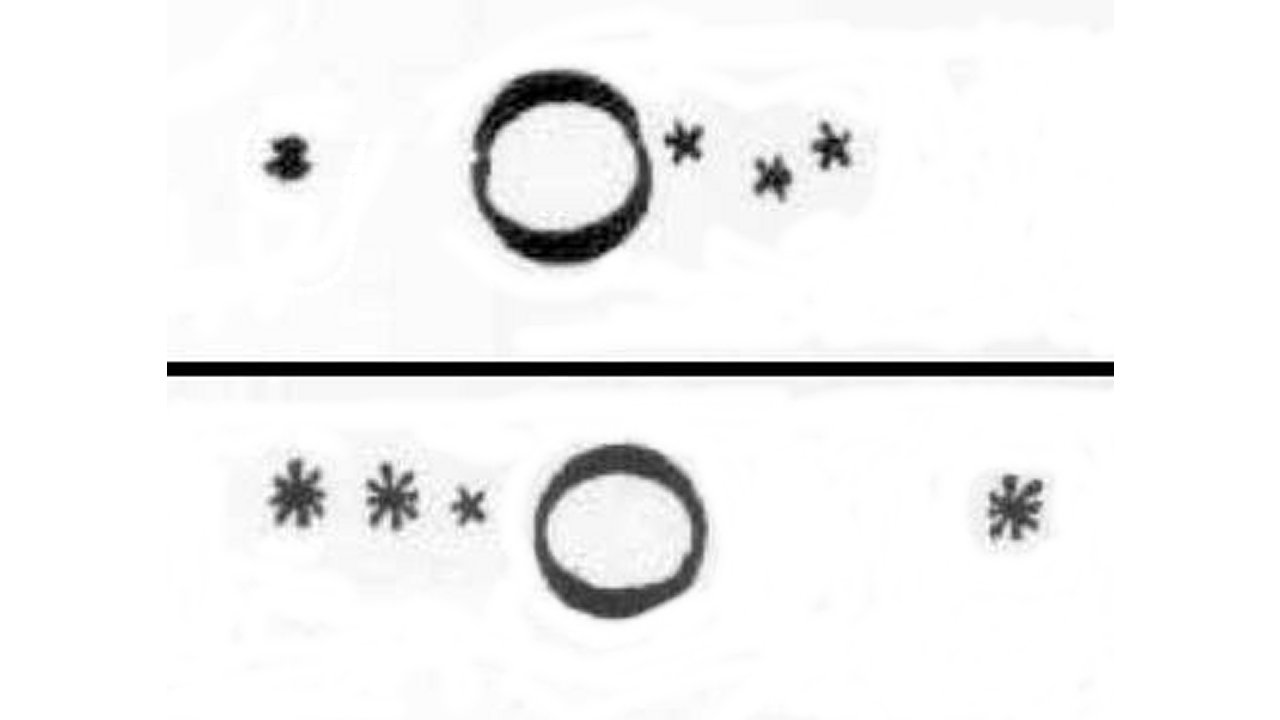 This theory was elaborated upon by Johannes Kepler in the early 17th Century, who, after more careful observations, deduced the proper shape of the planetary orbits, which was that of the ellipse. An ellipse can be viewed as a circle as seen from an angle. The perfection of the cosmos was starting to shatter with the realisation that not even the orbits of the heliocentric system were purely circular as previously believed. Galileo, a few years later and using the recently invented telescope, noted four moons in orbit around Jupiter and this was further proof that the Earth was not the centre of all things.
This theory was elaborated upon by Johannes Kepler in the early 17th Century, who, after more careful observations, deduced the proper shape of the planetary orbits, which was that of the ellipse. An ellipse can be viewed as a circle as seen from an angle. The perfection of the cosmos was starting to shatter with the realisation that not even the orbits of the heliocentric system were purely circular as previously believed. Galileo, a few years later and using the recently invented telescope, noted four moons in orbit around Jupiter and this was further proof that the Earth was not the centre of all things.
Many of us will have a picture of the layout of the Solar System as a series of concentric circles of increasing size, with the Sun at the centre. The normal view is of a static, disc shape, as if the orbits are the grooves in an LP record (if you can remember what that was!) and the Sun is the hole in the centre. This is generally adequate when thinking purely in terms of being within the Solar System but our Sun and its attendant planets and their moons are part of an immensely bigger structure; the Milky Way Galaxy.
Far from this static model, the Sun is orbiting the centre of our galaxy at great speed and taking the Solar System with it. Although it takes an enormous period of time, roughly 225 million years or so, to carry out one orbit of the centre of the galaxy, the distance involved is so huge that it is doing this at an enormous speed of 230 kilometres per second. So, the picture then is of the planets orbiting the Sun as the Sun itself is hurtling around its orbit. As a result, the static picture of the Solar System as a disc is only partially correct; the disc itself is moving as well.
An interesting thought experiment is to imagine the track or trail of the planets as they circle the Sun whilst the Sun moves ever onward. Taking up this challenge, I decided to try to model this on my computer with a 3-D graphic package.
This became a fascinating project and the first step was to get some good data on the size of the planet’s orbits. In this day and age of the Internet and wikipedia this was a moment’s work. As soon as I started this, one of the key features of the arrangement of the Solar System became apparent. The four inner planets, Mercury, Venus, Earth and Mars, all have evenly spaced orbits. If you try to keep them visible at the same time, the four outer planets of Jupiter, Saturn, Uranus and Neptune are much more widely spread out. Trying to view the whole Solar System means that the four inner planets’ orbits are very small, barely discernable ellipses close to the Sun. That is why astronomers often talk about the inner Solar System, in which we reside, and contrast this with the more far-flung outer Solar System.
Another feature of trying to display the Solar System in this way is that the planets, even the large gas giants like Jupiter and Saturn, are tiny compared to the size of their orbits. If you really were to draw the planets at the same scale as their orbits and fit it all on one computer screen, it would be very difficult to see them. You might see the Sun as a bright pixel in the centre and fleetingly you might glimpse the gas giants, but that would be it. To aid the viewer, you have to have a different scale for the size of the planets compared to their orbits.
As I worked on this, I was eventually able to simulate the orbits of all eight planets as they revolved around the Sun, as the Sun in turn moved forward through the galaxy. I kept it simple in a number of ways. Firstly, each planet’s orbit is inclined at a slight angle that is different for each planet. In other words, each of the orbits are in a different plane compared to the others, that all intersect (roughly) about the Sun. By and large however, the inclination of the orbits is relatively small so I ignored this point. It would be difficult to notice this on my simulation in any event. In addition, as noted above, the orbit of each planet is not a true circle but is an ellipse. In practise however, they are near enough to a circle to make little difference at the scale of my simulation and again it would be difficult to notice this point.
The exception to these points is Mercury. The angle of Mercury’s orbit is a little larger than the other planets and is also a more pronounced ellipse. I decided to not take this any further though as Mercury’s orbit is very small compared to the other planets, especially the outer ones, so that again it would be difficult to notice this.
Another interesting point about the orbits of the planets is that we generally think of them as being centred on the Sun. An ellipse has in fact what you might think of as two “centres” and these are called focal points or focuses. One of the focuses of the Earth’s orbit, for instance, is within the Sun. But it is not, as might be thought, in the exact centre of the Sun. Instead, when a planet orbits a star, they both orbit the centre of mass of the two of them. As an example of this principle, imagine two planets of the exact same mass and density and so forth orbiting each other. They would orbit around the centre of mass between the two of them.
With the Earth and the Sun the situation is a little different. The Sun is so hugely massive compared to the Earth that one of the focal points of the orbit is within the Sun itself, albeit not actually at the Sun’s exact centre. The same holds true for all the other planets apart from Jupiter. Jupiter is so massive that the focal point of its orbit is just beyond the Sun’s surface. As a result, the Sun orbits this point and so if you studied the Sun very carefully, you would notice it revolving around a point just beyond its outer edge.
This “wobble” is one of the ways astronomers use to determine if other stars have planets orbiting them. If they are suitable massive compared to their star, they may also pull the star around in a similarly tight orbit.
This effect was so small that I felt there was no need to include it in my simulation as again it would be very difficult to see this on a scale that involved the orbits of all the Solar System’s planets.
After running it, the simulation produced some beautiful spiral shapes as the planets orbited the Sun as the Sun itself orbited the centre of the galaxy. Of course, my simulation had to run at a much higher speed than the real Solar System. After all, it takes a whole year for the Earth to orbit the Sun and at that speed, the little sphere on my screen representing the Earth on my screen would move slower than the hour hand of a clock! So, in the end I settled for each minute of my simulation representing roughly twenty years of real time.
One final point was the angle of the Solar System as it proceeds in its orbit around the centre of the galaxy. It was tempting to assume that it was horizontal or vertical compared to this movement, but in fact it is tilted at sixty degrees to the direction of its movement around the centre of the galaxy. This means that some of the planets may be ahead of the Sun in its orbit whilst the others are behind it. As the planets’ orbits progress, these relative positions switch around. Think of somebody with an umbrella in the rain who has to angle the umbrella slightly forward to account for the wind as they walk and you get the picture.
Watching the simulation was quite entrancing. The intertwining spirals (or helixes as they should be called) were a manifestation of nature’s uplifting beauty. I soon realised that I had in fact missed one further point. In creating my simulation, I had simply assigned a value to the speed of the Sun’s orbit around the galaxy’s centre that was convenient and seem to make for an interesting result. I had not actually considered what this ought to be.
By entering the correct value of the speed of the Sun’s orbit, I realised that the Sun, along with the rest of the Solar System including the Earth, were orbiting the centre of the galaxy at a rate far greater than the speed of the Earth’s orbit around the Sun. For instance, in a year the Earth will travel roughly one billion kilometres as it revolves around the Sun. In the same time however, it will have travelled around seven billion kilometres as the Solar System orbits the galaxy’s centre.
This changed the look of the simulation rather markedly. Although the helix shapes are still there, they are much more elongated. In fact, the overall impression now is that the track of the movement of the planets are long streamers or tails stretching out around the Sun. This was an unexpected result and added an element of discovery into what had already been a fascinating and absorbing project.
To make the simulation more sophisticated, the points referred to above would have to be added in. In addition, at the scale shown in my animations, the movement of the Sun is as near to a straight line as makes no difference. Yet for it to be accurate this ought to be taken into account.
In addition, the orbit of the Solar System around the galaxy’s centre is not a flat a plane. It oscillates gently up and down, roughly four times during one orbit. A further simulation could show this as well to make the picture more complete, although again this motion is so enormous that at the scale shown in my simulations it is unlikely that you will be able to see this.
I had learned a great deal from this project. As with the movement from a geocentric to a heliocentric model of the Solar System, the incomprehensible expanse of space and our world’s minute dimensions in comparison are the impressions one is left with. Our precious, beautiful planet is a tiny, living pin point in the enormity of the dark and we are so lucky enough to briefly exist on this shore of the cosmos.
A vlog that contains the animations I created as part of this project is set out below – please do take a view!

 Through a local community group that I belong too, we’ve been in contact with a professional ecologist called Phil Budd and he’s been kind enough to take us on guided walks along the shore. An amble like this with Phil is a revelation. Even early on in our trip to the beach, his knowledge wakes you up to how the plants and animals in your local area form part of an ecosystem as vibrant and intricate as any tropical jungle or temperate forest.
Through a local community group that I belong too, we’ve been in contact with a professional ecologist called Phil Budd and he’s been kind enough to take us on guided walks along the shore. An amble like this with Phil is a revelation. Even early on in our trip to the beach, his knowledge wakes you up to how the plants and animals in your local area form part of an ecosystem as vibrant and intricate as any tropical jungle or temperate forest.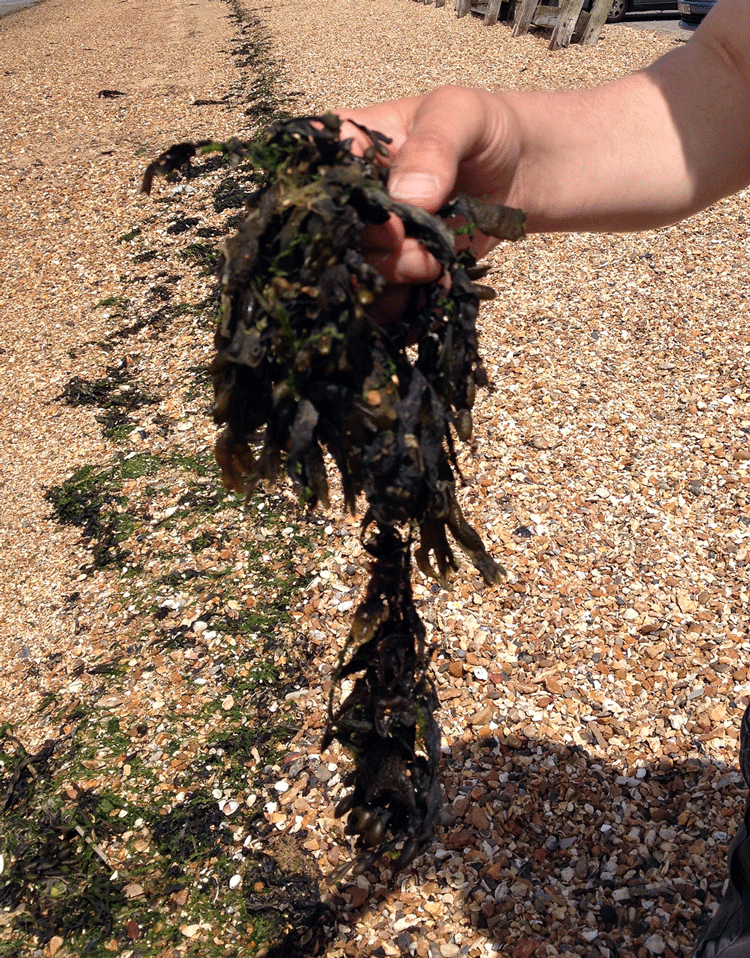 On the tide line at the shore is a common type of seaweed called bladderwrack. This is a habitat for the imaginatively named Seaweed fly and these flies in turn are eaten by some of the birds that visit the area. Those birds in turn are eaten by birds of prey like the sparrowhawk. Similarly, a beautiful plant called sea purslane is a habitat for insects such as the lesser marsh grasshopper, which again leads to higher steps in a food chain.
On the tide line at the shore is a common type of seaweed called bladderwrack. This is a habitat for the imaginatively named Seaweed fly and these flies in turn are eaten by some of the birds that visit the area. Those birds in turn are eaten by birds of prey like the sparrowhawk. Similarly, a beautiful plant called sea purslane is a habitat for insects such as the lesser marsh grasshopper, which again leads to higher steps in a food chain. I was intrigued to learn that a number of the plants on the shore are perfectly edible (subject to washing, boiling or steaming as appropriate). Sea purslane goes well with fish, for example, or in a salad. Another common plant on the shore is sea beet, the wild ancestor of plants such as beetroot, sugar beet and Swiss chard. It can be eaten cooked or even raw – although none of us were brave enough to try it there and then! Other plants found on the shore can be used in herbal teas or as remedies. These plants have the potential to be something of a treasure trove to foragers.
I was intrigued to learn that a number of the plants on the shore are perfectly edible (subject to washing, boiling or steaming as appropriate). Sea purslane goes well with fish, for example, or in a salad. Another common plant on the shore is sea beet, the wild ancestor of plants such as beetroot, sugar beet and Swiss chard. It can be eaten cooked or even raw – although none of us were brave enough to try it there and then! Other plants found on the shore can be used in herbal teas or as remedies. These plants have the potential to be something of a treasure trove to foragers.
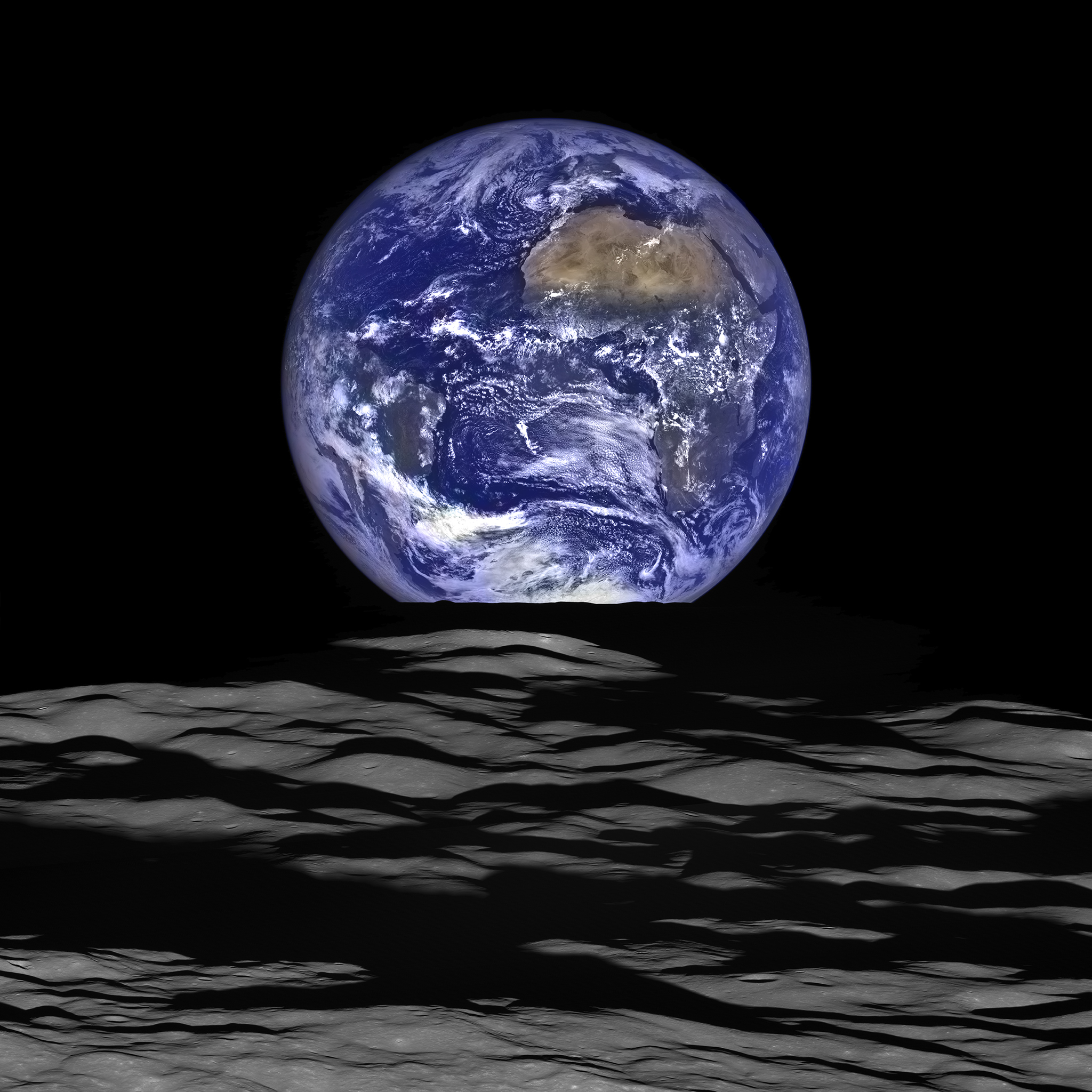 In his announcement about his plans for Mars, Musk listed advantages that the red planet has over our Moon. Yet it is clear that, as both a stepping stone to further exploration of space and a destination in its own right, Luna (another name for the Moon, which I prefer) has some very practical advantages. It is of course, much, much nearer than Mars. The Moon is about 384,000 km (239,000 miles) distant. At its nearest, Mars is 55 million km (34 million miles) away; that is around 143 times the distance to the Moon. As it circles the Sun in its own orbit, Mars spends a lot of time much further from Earth than that.
In his announcement about his plans for Mars, Musk listed advantages that the red planet has over our Moon. Yet it is clear that, as both a stepping stone to further exploration of space and a destination in its own right, Luna (another name for the Moon, which I prefer) has some very practical advantages. It is of course, much, much nearer than Mars. The Moon is about 384,000 km (239,000 miles) distant. At its nearest, Mars is 55 million km (34 million miles) away; that is around 143 times the distance to the Moon. As it circles the Sun in its own orbit, Mars spends a lot of time much further from Earth than that. My last entry in this list of advantages is solar energy. Luna is on average the same distance from the Sun as Earth, but its atmosphere is so tenuous that it may as well be described as a vacuum. The solar energy hitting a panel on Luna would be more than that on Earth as a result. Mars on the other hand is further away from the Sun than either Earth or Luna and so the solar energy it receives is rather less.
My last entry in this list of advantages is solar energy. Luna is on average the same distance from the Sun as Earth, but its atmosphere is so tenuous that it may as well be described as a vacuum. The solar energy hitting a panel on Luna would be more than that on Earth as a result. Mars on the other hand is further away from the Sun than either Earth or Luna and so the solar energy it receives is rather less. This is litter – the curse of modern living; something that is so ubiquitous we often fail to consciously register it is there. Litter is usually all round us everywhere – a seemingly inevitable by-product of the sublime efficiency of our industrial world culture. Yet there is a growing movement, assisted and inspired by the internet’s rapacity for communication, that aims to face up to this incessancy.
This is litter – the curse of modern living; something that is so ubiquitous we often fail to consciously register it is there. Litter is usually all round us everywhere – a seemingly inevitable by-product of the sublime efficiency of our industrial world culture. Yet there is a growing movement, assisted and inspired by the internet’s rapacity for communication, that aims to face up to this incessancy.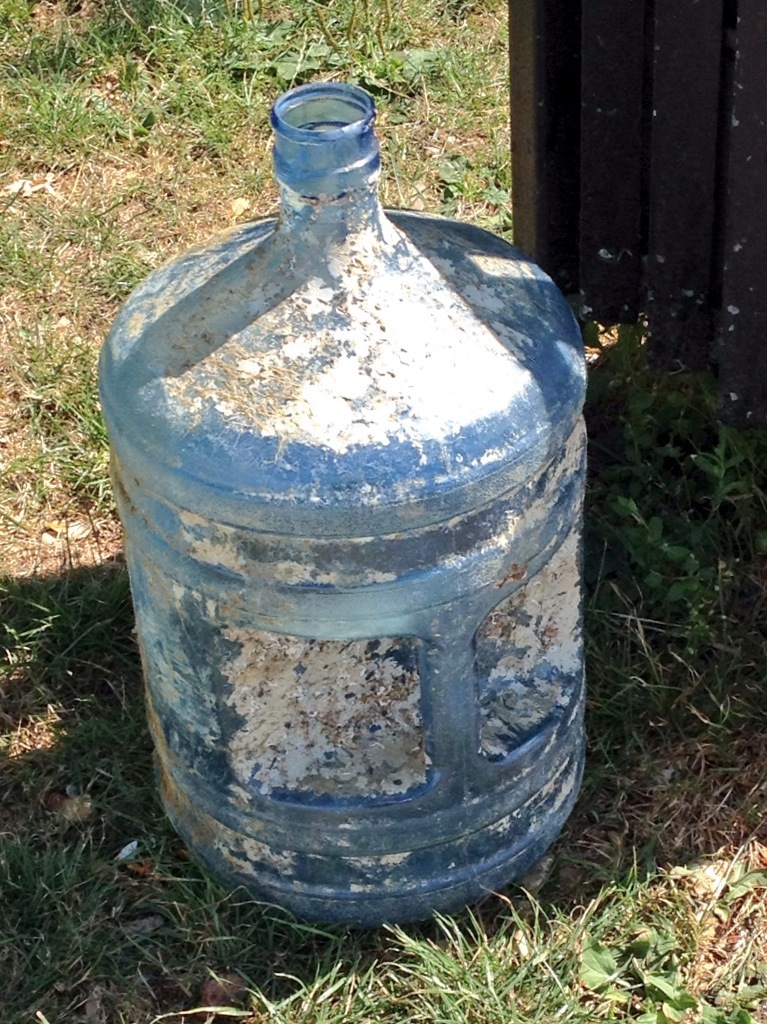 As an environmental issue, litter can have devastating effects on wildlife. There have been videos and photos of turtles with plastic forks and straws stuck in their noses. A dramatic case is that of Peanut, a red-eared slider turtle, who became stuck in a six-pack can binder as a youngster and grew up deformed as a result. Not only did this affect the turtle’s internal organs, it would have also made her more vulnerable to predators as it affected her mobility. Similar cases involve pelicans, albatrosses and other sea birds. Recently, thirteen sperm whales that died after becoming stranded on a beach in Germany were found to have stomachs full of plastic. Seals can become caught up in old rope, netting or fishing line and drown.
As an environmental issue, litter can have devastating effects on wildlife. There have been videos and photos of turtles with plastic forks and straws stuck in their noses. A dramatic case is that of Peanut, a red-eared slider turtle, who became stuck in a six-pack can binder as a youngster and grew up deformed as a result. Not only did this affect the turtle’s internal organs, it would have also made her more vulnerable to predators as it affected her mobility. Similar cases involve pelicans, albatrosses and other sea birds. Recently, thirteen sperm whales that died after becoming stranded on a beach in Germany were found to have stomachs full of plastic. Seals can become caught up in old rope, netting or fishing line and drown.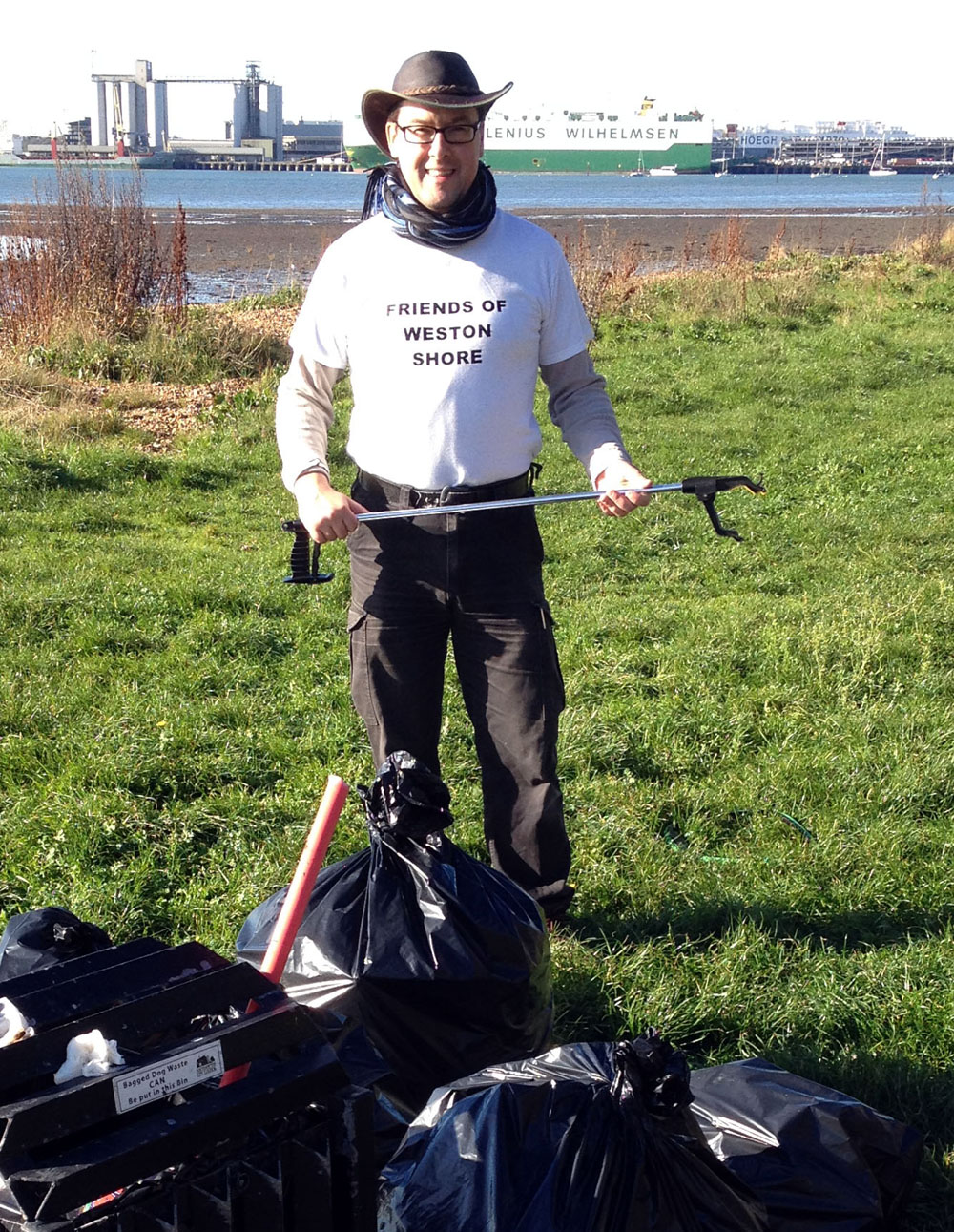 Thankfully, litter’s very visibility has lead to many people wanting to take action. Groups all over the world regularly carry out litter picks and clean ups and it’s no surprise that these have become popular in recent years.
Thankfully, litter’s very visibility has lead to many people wanting to take action. Groups all over the world regularly carry out litter picks and clean ups and it’s no surprise that these have become popular in recent years.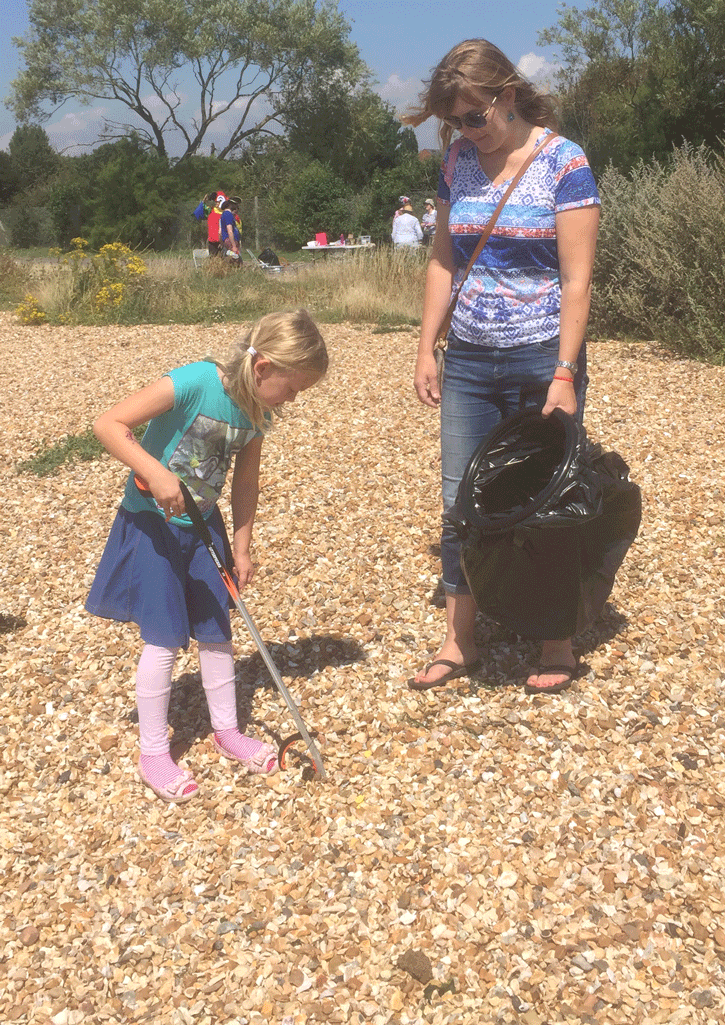 Litter picking as an activity has grown in popularity in the age of social media. It is often a very visual subject for the camera and sometimes can be rather bizarre. Diamond (or more likely, fake diamond) studded dog collars, bits of alarm clocks, toys of all descriptions, innumerable golf balls, parts of cars, the complete range of types of clothing – all have been found on litter picks. This makes for a good subject for instagramming, tweeting and so forth.
Litter picking as an activity has grown in popularity in the age of social media. It is often a very visual subject for the camera and sometimes can be rather bizarre. Diamond (or more likely, fake diamond) studded dog collars, bits of alarm clocks, toys of all descriptions, innumerable golf balls, parts of cars, the complete range of types of clothing – all have been found on litter picks. This makes for a good subject for instagramming, tweeting and so forth.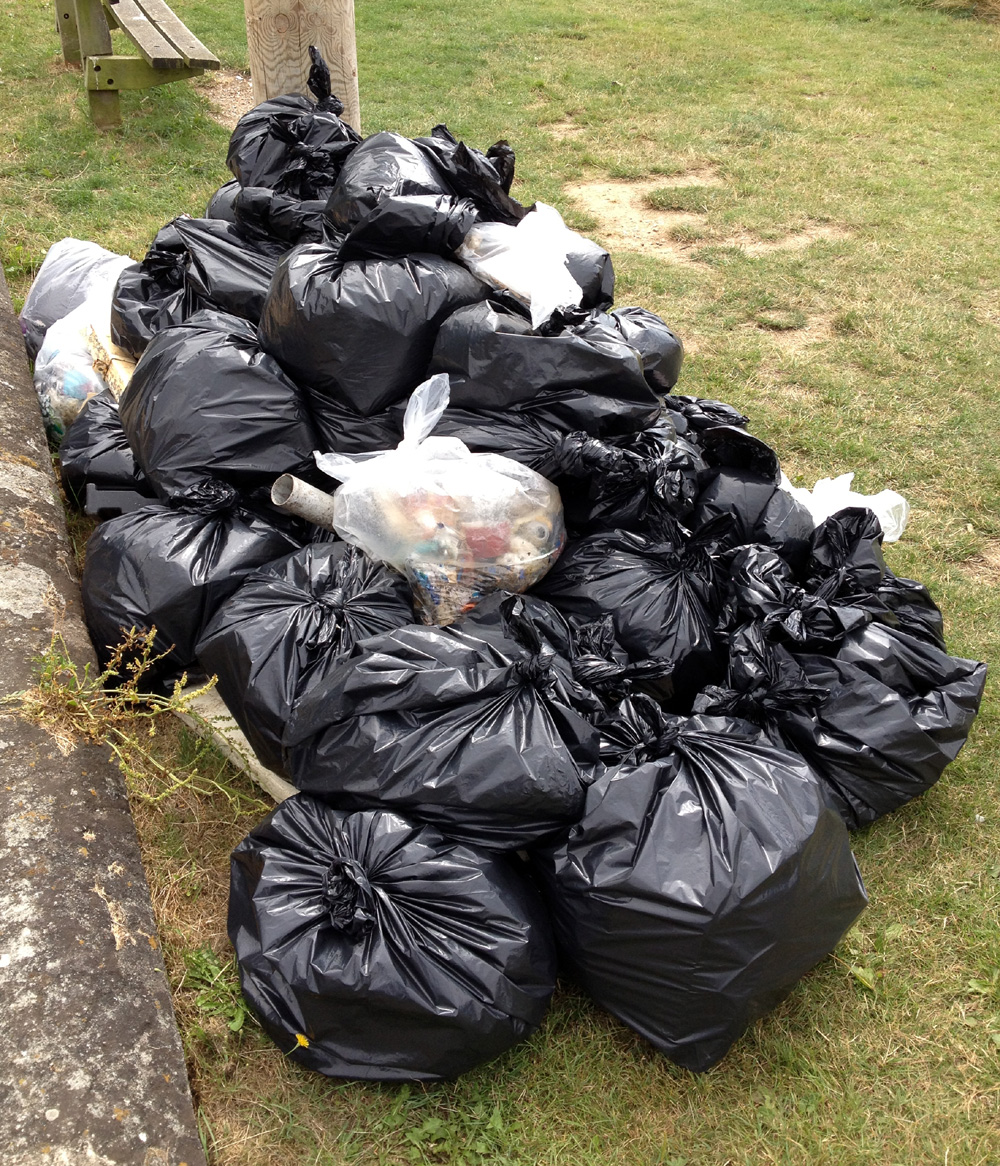 A similar movement is #2minutebeachclean. The idea here is to do a little and often. A two minute clean up really can help and spreading the meme helps more get done.
A similar movement is #2minutebeachclean. The idea here is to do a little and often. A two minute clean up really can help and spreading the meme helps more get done. With a sense of achievement from this type of activity, facing up to the greater challenges seems more reasonable. If we can make a difference here and now, maybe making a difference with these more profound difficulties is not so impossible. Just maybe, there is good reason to hope after all.
With a sense of achievement from this type of activity, facing up to the greater challenges seems more reasonable. If we can make a difference here and now, maybe making a difference with these more profound difficulties is not so impossible. Just maybe, there is good reason to hope after all.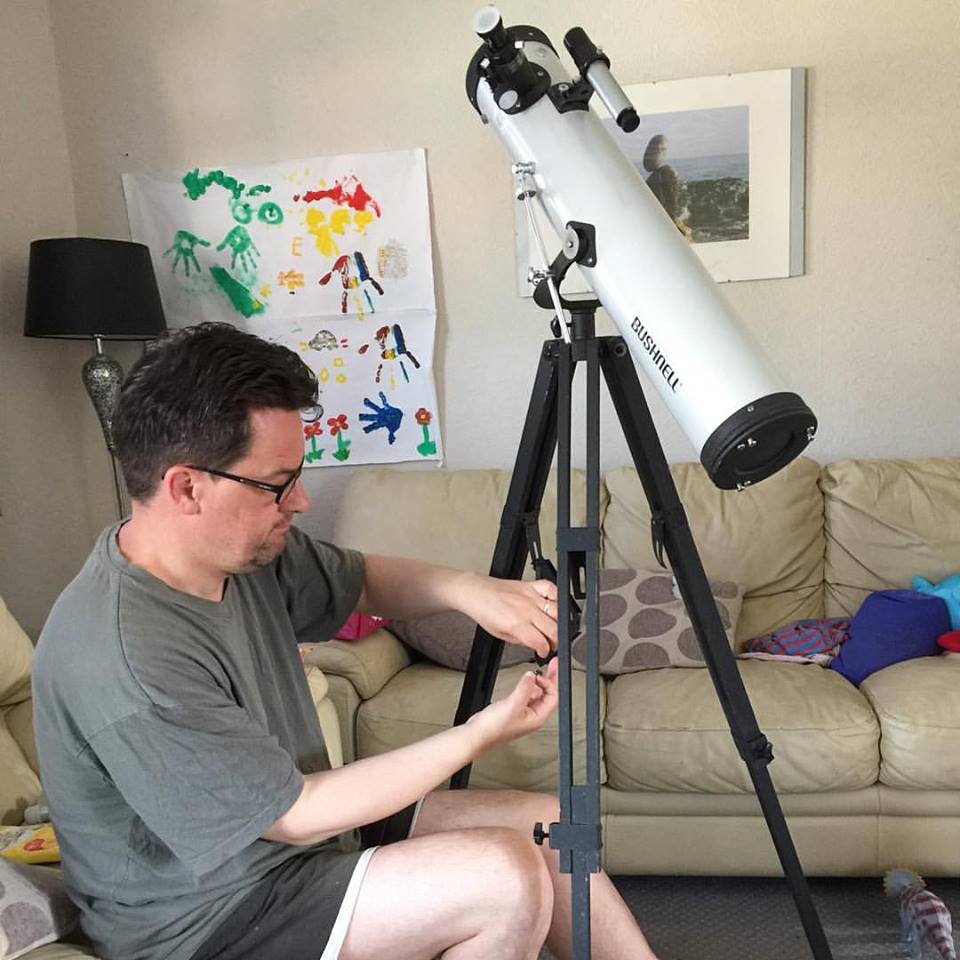 The specific model was a Bushnell 78-9003, which appears to be quite representative of the type of telescope that can be purchased relatively inexpensively for use at home. Examining it, my first impression was of how beautiful this instrument was, the shining chrome and circular lenses arranged in a mathematical perfection. I’m not naturally a practical person by inclination, so carrying out the assembly work that was required was an enjoyable challenge.
The specific model was a Bushnell 78-9003, which appears to be quite representative of the type of telescope that can be purchased relatively inexpensively for use at home. Examining it, my first impression was of how beautiful this instrument was, the shining chrome and circular lenses arranged in a mathematical perfection. I’m not naturally a practical person by inclination, so carrying out the assembly work that was required was an enjoyable challenge.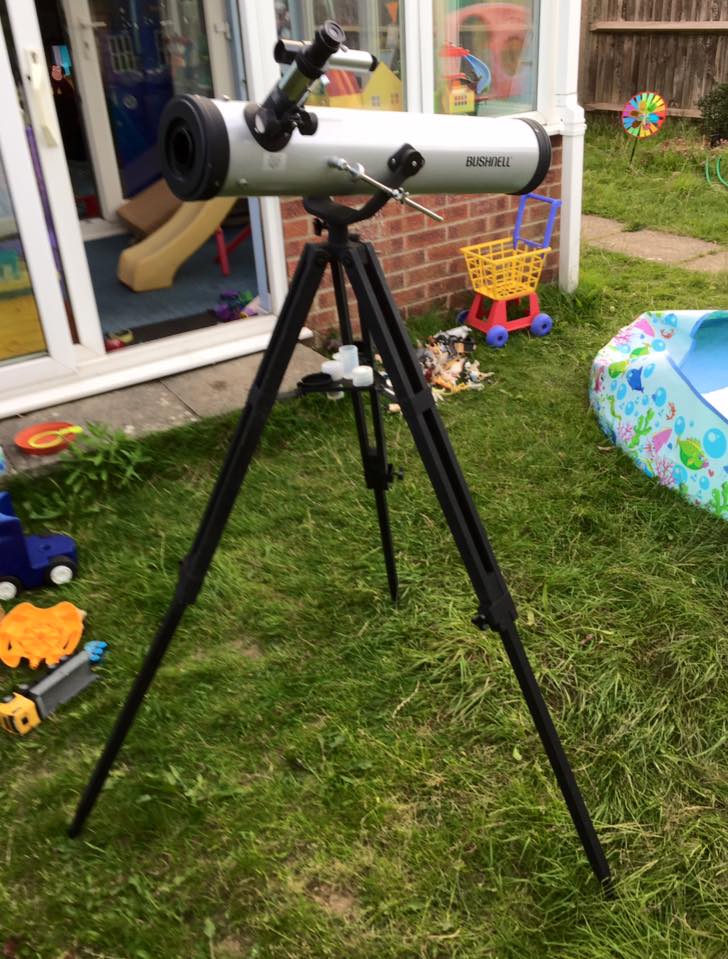 It looked large enough in the Finderscope, but when I used the low power 20mm lens in the main telescope to view it, I had a shock. The top of the post had a rubber stopper on it. In the eyepiece of the main telescope, this was so close I could see every wrinkle and crease in the stopper’s orange surface. This magnifying power was impressive! I could easily imagine how astonished the telescope’s original inventors might have been.
It looked large enough in the Finderscope, but when I used the low power 20mm lens in the main telescope to view it, I had a shock. The top of the post had a rubber stopper on it. In the eyepiece of the main telescope, this was so close I could see every wrinkle and crease in the stopper’s orange surface. This magnifying power was impressive! I could easily imagine how astonished the telescope’s original inventors might have been.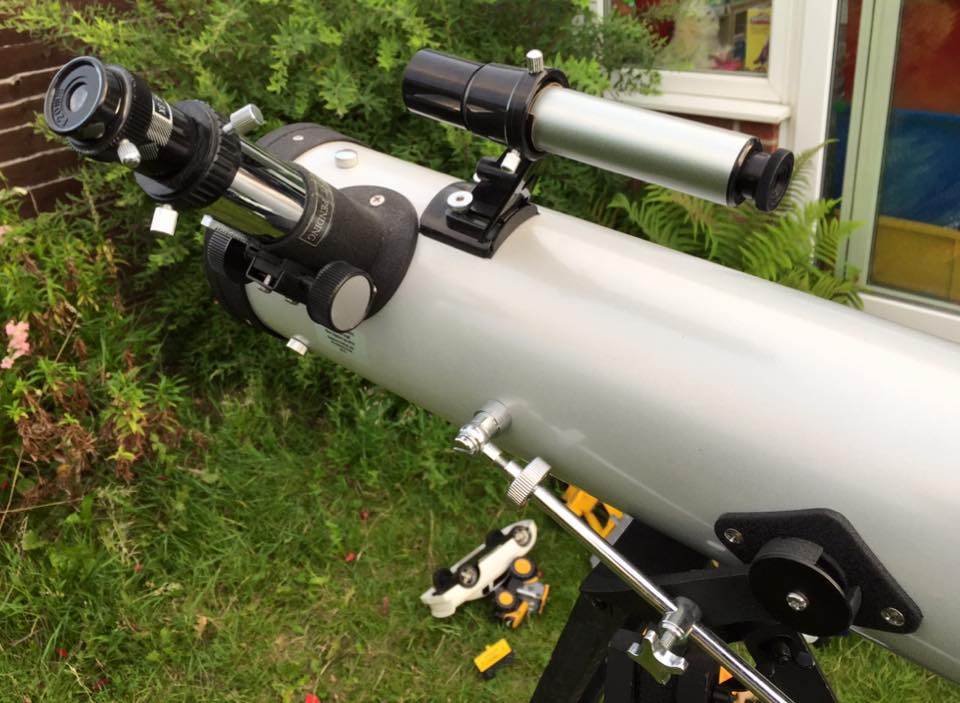 One thing I noticed immediately was that a telescope such as mine is very sensitive to the slightest touch or wobble. Whenever possible, I tried to lock it into position as much as I could to prevent this, but this proved somewhat tricky. The act of tightening the telescope’s adjustment screws could move the main eyepiece off target. Looking through the eyepiece had to be done delicately as pressing too hard could easily move the telescope the tiniest fraction, thus taking the view off the Moon.
One thing I noticed immediately was that a telescope such as mine is very sensitive to the slightest touch or wobble. Whenever possible, I tried to lock it into position as much as I could to prevent this, but this proved somewhat tricky. The act of tightening the telescope’s adjustment screws could move the main eyepiece off target. Looking through the eyepiece had to be done delicately as pressing too hard could easily move the telescope the tiniest fraction, thus taking the view off the Moon.

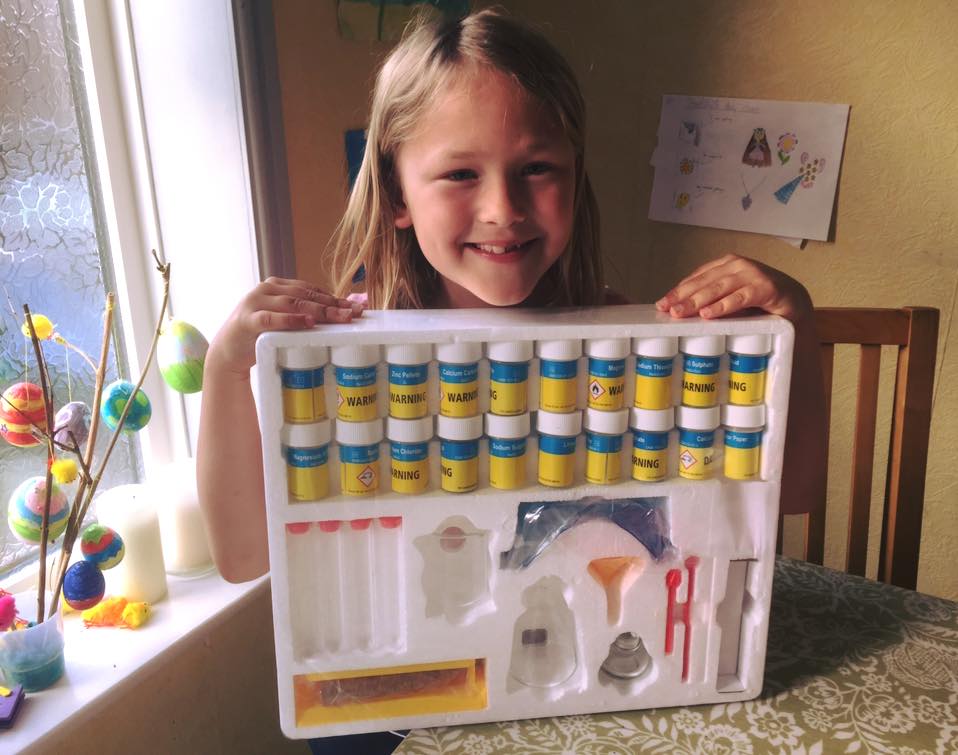
 We quickly set to work arr
We quickly set to work arr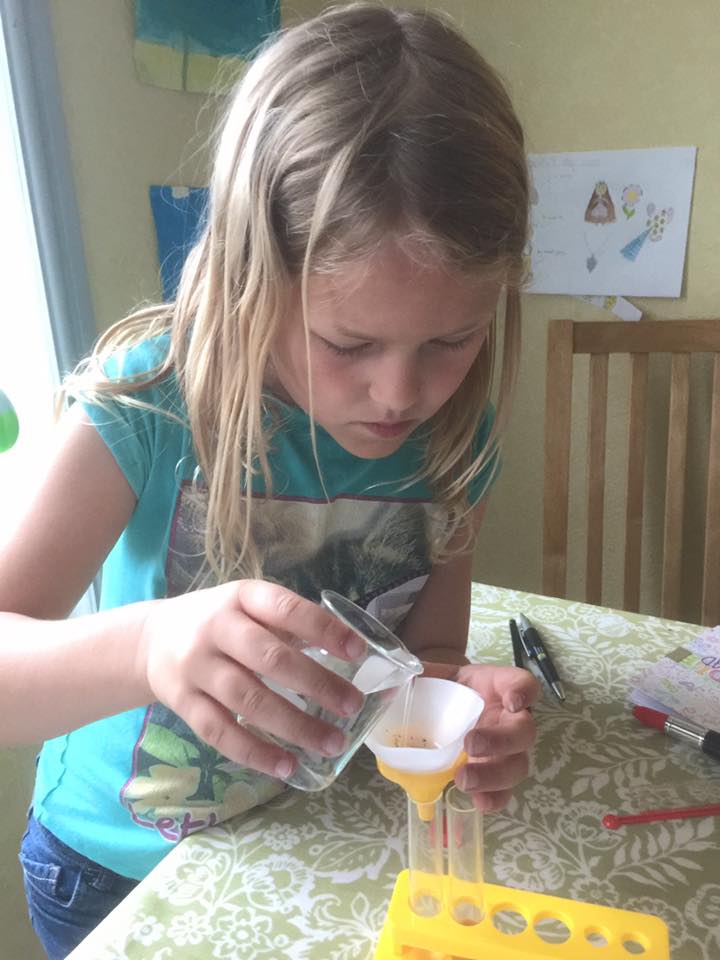 Elizabeth is learning a lot of science of course. For instance, she now knows that sodium chloride is of course salt, that heating solutions speeds up the dissolving process and that sugar crystals are yummy. Almost as useful are the practical skills involving a certain manual dexterity – the pouring, holding and measuring. One of the themes of the booklet with our set is predicting (or at least imagining) what the results of any particular experiment might be beforehand and this is a valuable exercise in itself. Not only is it part of the learning process; this experience I’ve found brings you right into the world of your child as you share the way they think about what is happening.
Elizabeth is learning a lot of science of course. For instance, she now knows that sodium chloride is of course salt, that heating solutions speeds up the dissolving process and that sugar crystals are yummy. Almost as useful are the practical skills involving a certain manual dexterity – the pouring, holding and measuring. One of the themes of the booklet with our set is predicting (or at least imagining) what the results of any particular experiment might be beforehand and this is a valuable exercise in itself. Not only is it part of the learning process; this experience I’ve found brings you right into the world of your child as you share the way they think about what is happening.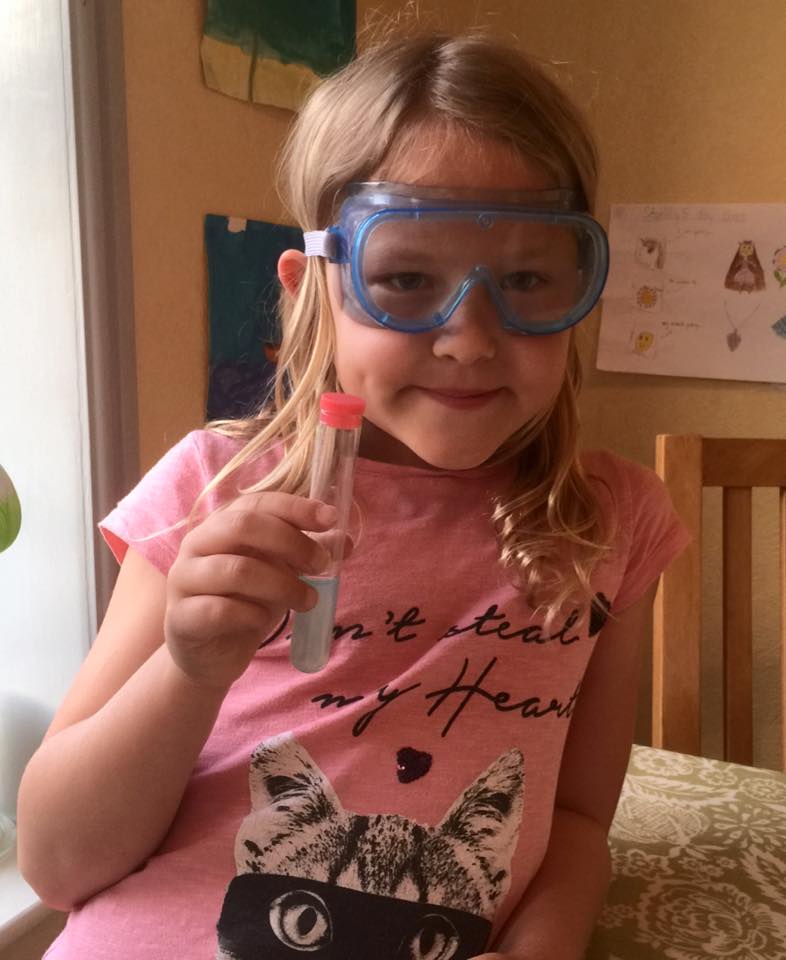 As we progress through the experiments, we’ve talked about further science adventures with sets involving physics and electronics and even a computer kit. Both of us are learning so much and I’ve loved how “doing science” has become a happy time for us as father and daughter.
As we progress through the experiments, we’ve talked about further science adventures with sets involving physics and electronics and even a computer kit. Both of us are learning so much and I’ve loved how “doing science” has become a happy time for us as father and daughter.
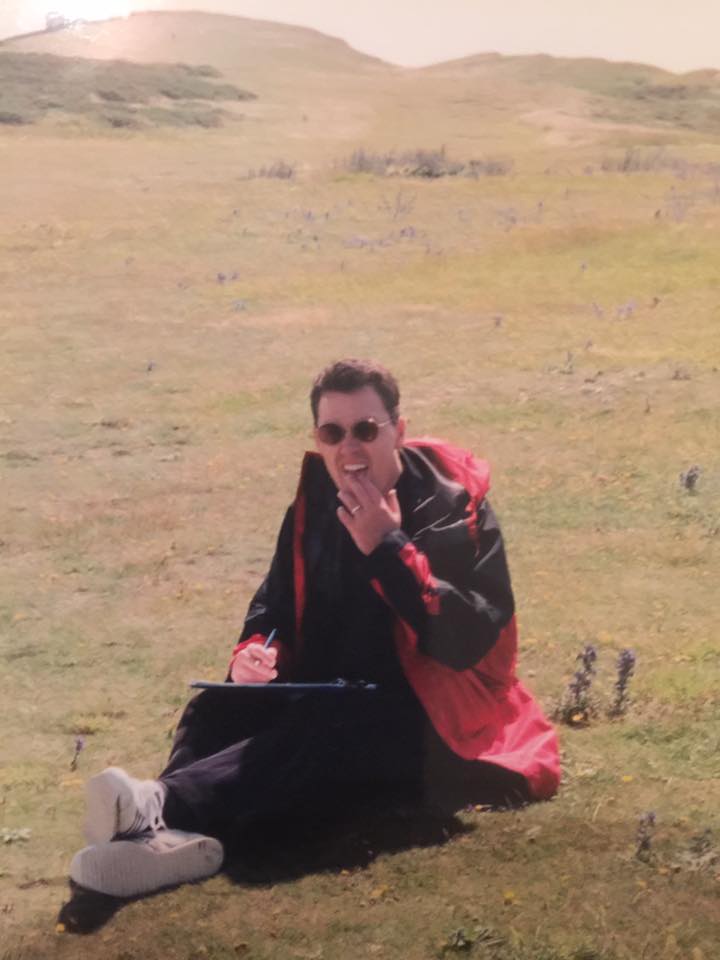 By
By 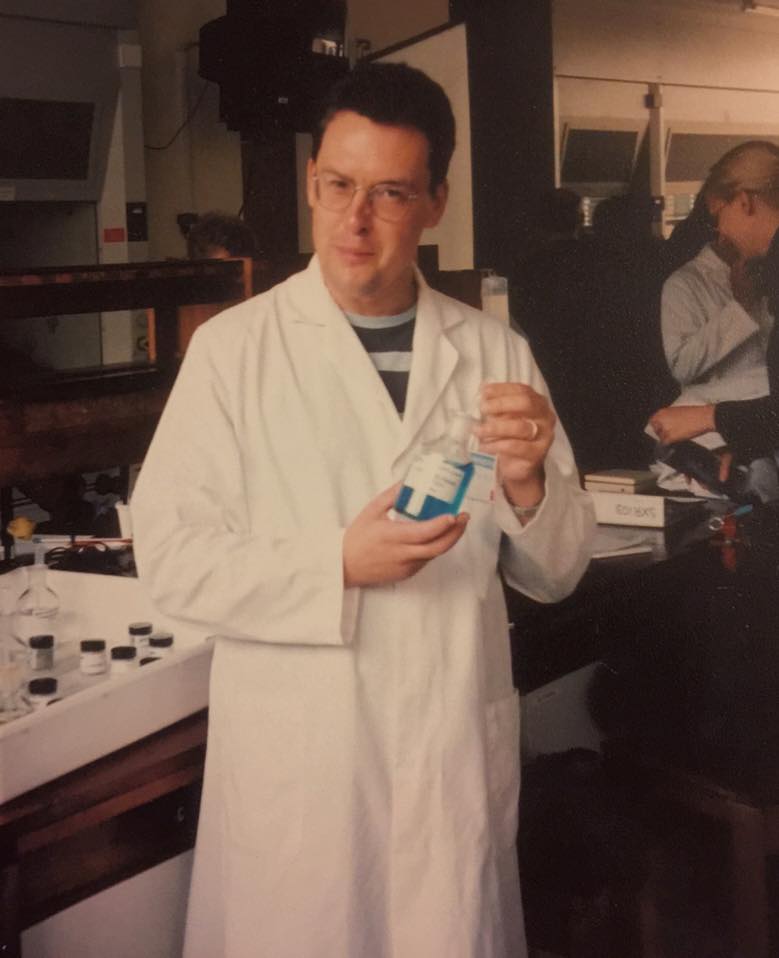 ructed on carrying out experiments and observations at home and I have a distinct memory of setting up a homemade spectrograph on the dinner table. Some of the course used material on a CD ROM, especially intensely studying an area of woodland and analysing the data from observations from the site and there were also the TV programmes which are a famous part of OU culture.
ructed on carrying out experiments and observations at home and I have a distinct memory of setting up a homemade spectrograph on the dinner table. Some of the course used material on a CD ROM, especially intensely studying an area of woodland and analysing the data from observations from the site and there were also the TV programmes which are a famous part of OU culture. Everyone wants to be happy.
Everyone wants to be happy. I used to keep a New Yorker cartoon taped to my printer. It showed a hooded death figure, scythe in hand, standing next to a writer seated at a typewriter. The caption was something like “Oh good, I’m glad you’re here. I can never get anything done without a deadline.”
I used to keep a New Yorker cartoon taped to my printer. It showed a hooded death figure, scythe in hand, standing next to a writer seated at a typewriter. The caption was something like “Oh good, I’m glad you’re here. I can never get anything done without a deadline.”